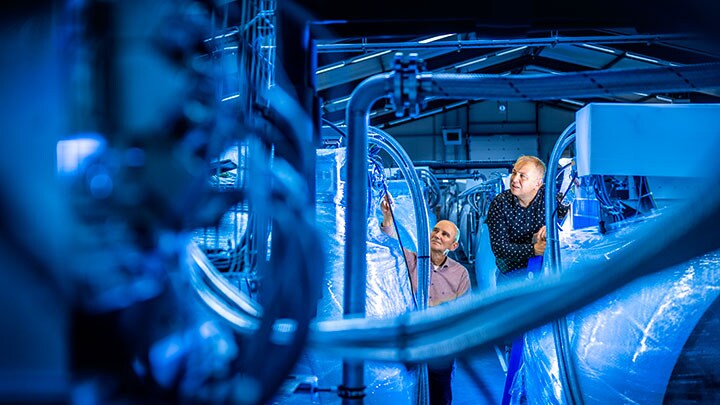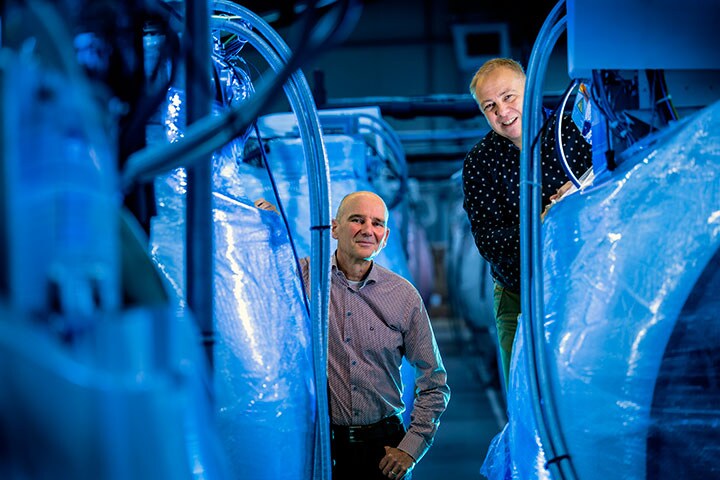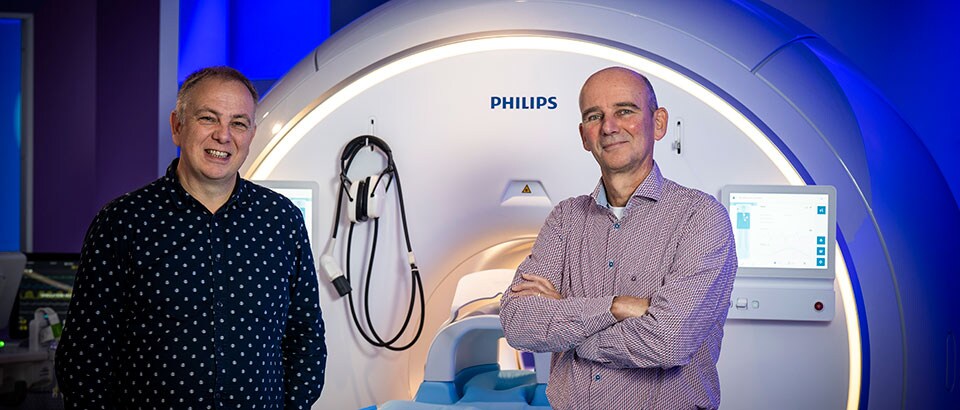De gezondheidszorg is verantwoordelijk voor 4 procent van de CO2-uitstoot wereldwijd; meer dan bijvoorbeeld de scheepvaart of de luchtvaart. Het goede nieuws is dat er veel innovatieve initiatieven ontstaan om de gezondheidszorg te verduurzamen, zowel bij ziekenhuizen als bij gezondheidstechnologiebedrijven zoals Philips.
Gert Mulder, Principal Systems Engineer bij Philips, kwam met zo'n innovatief idee. Een slimme aanpassing in hun koelsysteem kan het energieverbruik van MRI-machines aanzienlijk verminderen. Met dit idee won hij de Philips Energy Challenge, uit meer dan honderd inzendingen. Nu werkt hij samen met Henrie van de Zilver, Senior Systems Engineer, om het in praktijk te brengen.
Extreem lage temperatuur
Een belangrijk deel van het energieverbruik van een MRI-machine gaat naar het koelen van de magneet in het apparaat. Gert: "Dit proces gebruikt helium bij een extreem lage temperatuur van 4 Kelvin, ofwel 269 graden Celsius onder nul, wat dicht bij het absolute nulpunt ligt. We proberen die temperatuur zo constant mogelijk te houden, omdat die de kwaliteit van de MRI-beelden zou beïnvloeden.”
Ze proberen hierbij binnen een marge van 0,1 graad te blijven. Om dit te bereiken bevat het systeem ook een verwarmingselement. Daarmee kan de temperatuur worden verhoogd, zodra het systeem te koud wordt. Gert: “Het is een soort koelkast die tegelijkertijd koelt en verwarmt om temperatuurschommelingen te minimaliseren.”
Op vaste tijden
Het idee: wanneer de magneet van een MRI-machine niet in gebruik is om scans te maken, hoeft deze niet per se verwarmd te worden. De productie- en innovatielocatie van Philips in Best heeft bijvoorbeeld altijd zo'n honderd magneten op voorraad, klaar om in een systeem te worden ingebouwd. Die magneten worden gekoeld, maar omdat ze (nog) niet in gebruik zijn, mag de temperatuur nog wat schommelen.

"Je hoeft ze dus niet tegelijkertijd te koelen en te verwarmen. Samen met mijn collega's Kees Ham en Gert-Jan Lenting heb ik het idee uitgewerkt om de koeling op vaste tijden aan en uit te zetten, zodat de temperatuur constant blijft", legt Gert uit.
CO2-reductie van 834 ton per jaar
Tijdens het ontwikkelen van het idee hoorde het trio over de Philips Energy Challenge, die medewerkers uitdaagt om innovatieve ideeën in te dienen die helpen de CO2-uitstoot en het energieverbruik van systemen te verminderen.
De besparing die de oplossing kan opleveren is geschat op 1,8 miljoen kilowattuur per jaar, met een bijbehorende CO2-reductie van 834 ton per jaar. Dat is ongeveer evenveel als de uitstoot die gepaard gaat met het meer dan 450 keer vliegen van Amsterdam naar Bali. Gert "Daarnaast gaan ook de onderhoudskosten omlaag en hebben we minder piekcapaciteit in de fabriek nodig, wat ook kosten bespaart."
Veel besparing mogelijk
Het idee werd als winnaar gekozen uit meer dan honderd inzendingen. Het is al in gebruik in Best en andere locaties willen het ook invoeren. Henrie, die dagelijks werkt aan het verduurzamen van MRI-systemen, onderzoekt momenteel de mogelijkheid om deze slimme manier van koelen toe te passen in ziekenhuizen. "Het kan in ieder geval worden toegepast wanneer een MRI niet aan het scannen is, zoals 's nachts. Zo kun je zeker 50 procent van de tijd energie besparen.”
Het is belangrijk dat ze daarbij ook stilstaan bij de vraag welke invloed temperatuurschommelingen daadwerkelijk hebben op de kwaliteit van MRI-beelden, want daarover bestaat nog onzekerheid. Henrie: “Mogelijk kunnen we een grotere bandbreedte toepassen, waardoor we op deze manier ook een MRI-systeem in gebruik zouden kunnen koelen.”
Op afstand implementeren bij ziekenhuizen
Bij deze innovatie is het voor de MRI-machines niet nodig enkele fysieke aanpassing te ondergaan. Het vereist in principe alleen een softwareaanpassing. Veel MRI-scanners in ziekenhuizen hebben een internetverbinding, dus dit zou zelfs op afstand kunnen worden geïmplementeerd.

Gert was eerder betrokken bij een andere mijlpaal in de verduurzaming van MRI-systemen: "In 2018 hebben we als een van de eersten een MRI-machine ontwikkeld die vrijwel geen helium verbruikt. Traditioneel verdampt een MRI altijd een beetje helium. De zogenaamde BlueSeal-magneten worden gekoeld met vele kleine drukflesjes waaruit het helium niet kan ontsnappen. Dat betekent dat we in plaats van 1.500 liter slechts 7 liter helium nodig hebben. Dat is een veel duurzamere oplossing, ook omdat de apparaten daardoor langer meegaan."
Het duo ziet de vraag van ziekenhuizen naar duurzamere systemen sterk toenemen: "De keuze voor een leverancier wordt steeds meer beïnvloed door duurzaamheidsaspecten. Ook daarom is het belangrijk dat we bij Philips hierin voorop blijven lopen.”

Smarter cooling of MRI machines leads to a reduction in CO2 emissions equivalent to 450 flights from Amsterdam to Bali
The healthcare sector is responsible for 4 percent of CO2 emissions worldwide; more than – for example – the shipping industry or aviation. The good news is that many are coming up with innovative initiatives to green the healthcare sector, both at hospitals and at health technology companies such as Philips.
Gert Mulder, Principal Systems Engineer, came up with such an innovative idea. A smart adjustment in their cooling system can significantly reduce the energy consumption of MRI machines. With this idea he won the Philips Energy Challenge, out of more than a hundred entries. Now he is collaborating with Henrie van de Zilver, Senior Systems Engineer, to put it into practice.
Extremely low temperature
A significant portion of an MRI machine's energy consumption goes into cooling the magnet in the device. Gert: “This process uses helium at an extremely low temperature of 4 Kelvin, or 269 degrees Celsius below zero, which is close to absolute zero. We try to keep that temperature as constant as possible, because it is believed to affect the quality of the MRI images.
We try to stay within a 0.1 degree margin. In order to achieve this, the system also contains a heating element. This allows the temperature to be increased as soon as the system gets too cold. It is a kind of refrigerator that cools and heats at the same time in order to minimize temperature fluctuations.”
The idea: when an MRI machine's magnet is not in use to make scans, it doesn't necessarily have to be heated. The Philips production and innovation location in Best, for example, always has around a hundred magnets in stock, ready to be built into a system. These magnets are being cooled, but because they are not in use (yet), the temperature may fluctuate a little more.

”So you don't have to cool and heat them at the same time. Along with my colleagues Kees Ham and Gert-Jan Lenting, I worked out the idea of turning the cooling on and off at set times in order to keep the temperature constant.”
A CO2 reduction of 834 tons per year
While developing the idea, the trio heard about the Philips Energy Challenge, which challenges employees to submit innovative ideas that help reduce systems' CO2 emissions and energy consumption.
The saving the solution can achieve has been estimated to be 1.8 million kilowatt-hours per year, with a corresponding CO2 reduction of 834 tons per year. That is about as much as the emissions involved in flying from Amsterdam to Bali more than 450 times. “In addition, the maintenance costs will be reduced as well, and we will require less peak capacity in the factory, which also saves costs.”
The idea was chosen as the winner from more than a hundred submissions. It is already in use in Best, and other locations want to implement it as well. Henrie, whose day-to-day duties include constantly working on making MRI systems more sustainable, is currently investigating the possibility of applying this smart way of cooling in hospitals. “It can in any case be applied whenever an MRI is not scanning, such as at night. This means you will be able to save energy at least 50 percent of the time.
However, we are also forced to check the impact that temperature fluctuations actually have on the quality of MRI images, because there is still uncertainty about that. We may be able to apply a wider bandwidth, which means that we could cool an MRI system in use in this way as well.”
Implementing at hospitals remotely
MRI machines require no physical adjustment whatsoever to achieve this. It basically only requires a software change. Many MRI scanners in hospitals have an internet connection, so we could even implement this remotely.

Gert was previously involved in another milestone in making MRI systems more sustainable: ”In 2018, we were one of the first to develop an MRI machine that consumes virtually no helium. Traditionally, an MRI always vaporizes a little helium. The so-called BlueSeal magnets are cooled with many small pressure bottles from which the helium cannot escape. This means that, rather than 1,500 liters, we only need 7 liters of helium. That is a much more sustainable solution, also because it allows devices to last longer.”
The duo has seen a strong increase in hospitals' demand for more sustainable systems: “The choice of a supplier is increasingly influenced by sustainability aspects. That is another reason why it is important that, at Philips, we remain at the forefront in this respect.”












